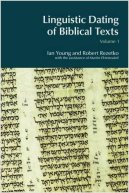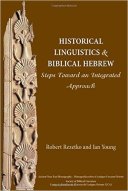Here’s one for the Hebrews and Shebrews.

 Conventional wisdom says that Early Biblical Hebrew (aka Standard Biblical Hebrew or Classical Biblical Hebrew) came first, and then Late Biblical Hebrew. But when you actually analyse the evidence, this view starts to unravel. Ian Young, Robert Rezetko, and Martin Ehrensvärd have argued very convincingly that Early Biblical Hebrew and Late Biblical Hebrew were not linear diachronic developments, but rather contemporaneous styles of Hebrew in antiquity. This means that it’s practically impossible to date a biblical text based solely on linguistic criteria. Their compelling argument can found in their two volume work, Linguistic Dating of Biblical Texts, and their more recent Historical Linguistics and Biblical Hebrew. Once you “see” their argument, you can’t “unsee” it. They look at the evidence in such a logical way that it makes you wonder why it has taken Hebraists so long to see what is so obvious.
Conventional wisdom says that Early Biblical Hebrew (aka Standard Biblical Hebrew or Classical Biblical Hebrew) came first, and then Late Biblical Hebrew. But when you actually analyse the evidence, this view starts to unravel. Ian Young, Robert Rezetko, and Martin Ehrensvärd have argued very convincingly that Early Biblical Hebrew and Late Biblical Hebrew were not linear diachronic developments, but rather contemporaneous styles of Hebrew in antiquity. This means that it’s practically impossible to date a biblical text based solely on linguistic criteria. Their compelling argument can found in their two volume work, Linguistic Dating of Biblical Texts, and their more recent Historical Linguistics and Biblical Hebrew. Once you “see” their argument, you can’t “unsee” it. They look at the evidence in such a logical way that it makes you wonder why it has taken Hebraists so long to see what is so obvious.
Yet many Hebraists still don’t see it. It almost feels like they’re looking at one of those pictures that have a “hidden” 3D shape (a stereogram, like this). They claim to be finding the 3D shape. And if you can’t see it, it’s because you’re not looking at the right way. Try squinting or staring beyond the page. But the irony is that the picture isn’t one of those 3D shapes! It’s just a normal 2D picture. They’ve been looking at it all wrong, and yet the real picture is there staring them in the face.
So the old and disproven paradigm persists. It seems to be dying a slow death, as evidenced by a few recent articles.

Robert Rezteko
Young, Rezetko, and Ehrensvärd have clarified their position in a paper titled “Do We Really Think That Ancient Hebrew Had No Chronology“.
Robert Rezetko has also put together a few responses to recent studies working with the old paradigm. They are well worth the read:
- “Response to Fassberg What is Late Biblical Hebrew“
- “Response to Joosten Pseudo-Classicisms in Late Biblical Hebrew“
- “Response to Shin A Diachronic Study of the Language of Haggai Zechariah and Malachi“
- “Response to Rooker Characteristics of the Hebrew of the Recognized Literary Divisions of Isaiah“
- “Response to Rendsburg Late Biblical Hebrew in the Book of Haggai“
I hope scholars, especially the younger ones, start just looking plainly at the evidence instead of squinting and forcing a particular paradigm onto it.


George, I know I need to read more widely on this, and will, but what’s your take on the fact that such a large range of distinctive terminology is limited, e.g., to Ezra-Nehemiah, Chronicles, and a few books like Esther, Ecclesiastes, Song of Songs, Haggai-Zech-Mal and some later Psalms? I come across this again and again, without setting out to prove a point. The posited LBH terms seem to match the appearance of Persian terms and the sudden burst of new Aramaic terms or Aramaic spelling influence.
These are largely stylistic choices. Actual Aramaisms and Persian loanwords are evidence of the influence of those languages on Hebrew. This is probably more obvious with Persian loanwoards. But Aramaic is a sister language of Hebrew, so it’s difficult to know if many so-called “Aramaisms” are actually the influence of Aramaic on Hebrew, or whether this is just a particular style (dialect?) of Hebrew that has terms resembling those we find in Aramaic. In any case, the main point is that linguistic criteria cannot be the sole criteria we use to date biblical books. They are not absolute criteria. We need other stakes in the ground to help us, like historical references, etc.
The old paradigm misuses the criterion of accumulation, arguing that if something has lots of “late” stuff in it, it must be late. But these books still have “early” stuff, too. And some “early” books (Samuel-Kings) have “late” features when the “late” books (Chronicles) replace those with “early” features. We even have scribes at Qumran writing in “Early” Hebrew with great ease (e.g. Pesher of Habakkuk). What’s going on? The best explanation is not that Early Hebrew leads on to Late Hebrew, but rather that these are different styles of Hebrew that are concurrent, and the authors/redactors pick their style. The reasons for their choice is another issue entirely.
P.S. I guess it comes down to the fact that the overtly post-exilic books or parts of books, along with a few implicitly or arguably post-exilic books, seem to manifest a new lingo. Anyway, I admit that I haven’t read a lot of the core literature yet, so am speaking under-informed. I take your advice and will move it up the priority list. AB.
Thanks George,
I don’t know about scholar at this point but I’ll try not to squint 😉
😑👍🏼
8)